Arch was gateway to St Leonards
This article contains affiliate links. We may earn a small commission on items purchased through this article, but that does not affect our editorial judgement.
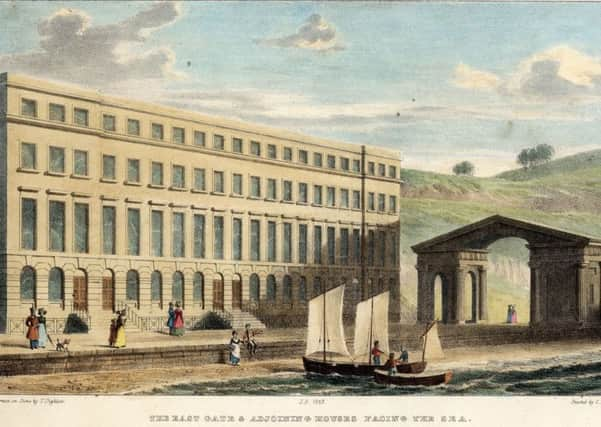

The town of St. Leonards didn’t exist before 1828.
The land had belonged to Charles Eversfield, who had died ten years earlier and his trustees had obtained powers to sell the property for the purposes of development.
On February 27th, 1828 James Burton acquired part of Gensing Farm, to the west of Hastings, for £7,800 and the first stone of the new town (The St.Leonards Hotel) was laid three days later on March 1 (1828 was a leap year).
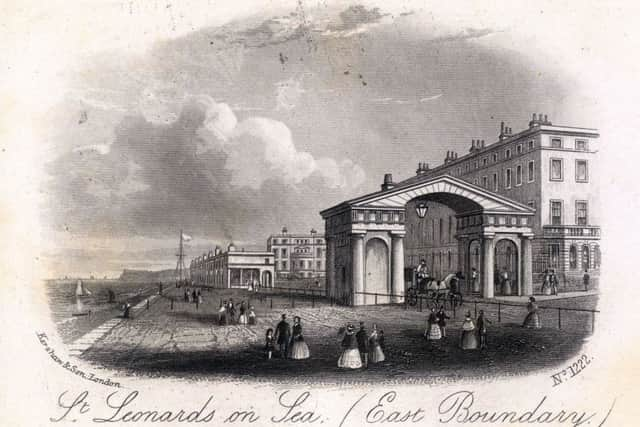

Advertisement
Hide AdAdvertisement
Hide AdBurton’s purchase had a frontage of 1,151 yards to the sea and lay across the almost empty parishes of St. Leonard and St Mary Magdalen.
By the end of 1828, Burton’s own house, the South Colonnade and the Archway, marking the eastern boundary of Burton’s new town of St.Leonards had been completed. By the following year, the town was beginning to take shape, with the completion of the main buildings-including the St. Leonard’s Hotel which later became the Royal Victoria.
The town was separate from and independent of Hastings and was governed by a board of commissioners who, in March 1866, set up their office north of the Archway, at No 1 Marina, in the single story building attached to No. 15 Marina (now a woodwork shop) and after that all their meetings were held there; the missing, even numbers, were allocated to South Colonnade demolished just after the last war.
By March 1873, the Commissioners decided St Leonards would be better off if it were part of Hastings and the last meeting was held at the Archway on January 12, 1875, to consider the draft Provisional Order submitted by the Local Government Board for dissolving the Commission and amalgamating it with the Hastings Town Council. This was finally dated 1885 and the town of St. Leonards ceased to exist.
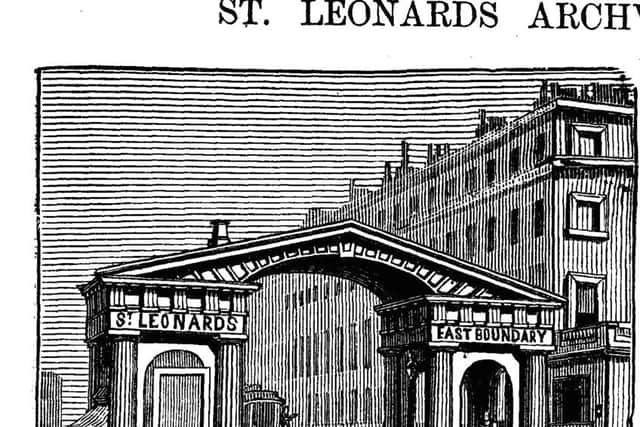

Advertisement
Hide AdAdvertisement
Hide AdThe Archway, formerly known as East Lodge, remained until 1895 as the last reminder of the former division between the two towns. There was a room in the southern section which had originally housed the St. Leonards beadle and had later become a shop.
In 1894 after much spirited opposition on the part of the ratepayers, who objected not so much to the removal of a well known landmark as to the payment of £1,700 to widen the road at that point by 45 inches, the decision to purchase and demolish it was passed by Hastings Council by 13 votes to II. During the night of January. 22, 1895, it was entirely removed within seven hours.
Curiously enough, as long ago as 1867 Decimus Burton had already suggested its removal. Interestingly; one of the conditions attached to the purchase was that a stone or other memorial to James Burton should be erected on or near the spot and a red granite memorial was erected at the roadside on the promenade between the bottom of London Road and Marine Court.
Building had started to the east of St Leonards, at Adelaide Place so it was felt that the town boundary should be more clearly marked. Alfred Burton was asked to add the words “Eastern Boundary of St.Leonards” on the Hastings side of the archway as can be seen in Parson’s picture. The postal boundary however was at White Rock and this caused problems to the owner of what is now Warrior Square who wanted all the land between Hastings and St. Leonards to be called “West Hastings”, and even requested the Postmaster General for letters addressed to persons living between the Archway and White Rock to be delivered from Hastings and not from St.Leonards. with the result that the morning letters were not delivered at 7.30 a.m. as usual but were held back.
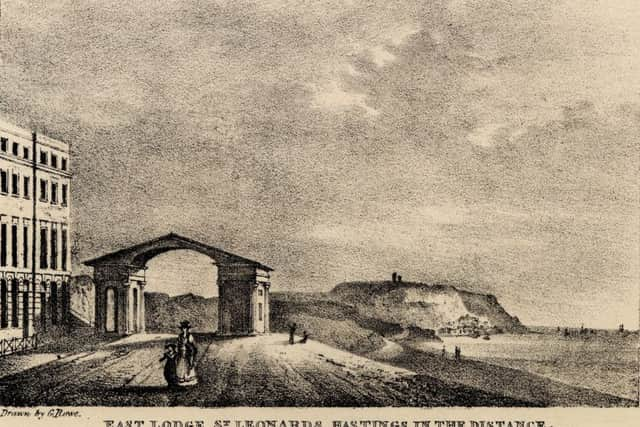

Advertisement
Hide AdAdvertisement
Hide AdAll illustrations throughout this series are from Ion Castro’s own collection and he can make available copies of many of the historic images used in this series. There’s more local history on Ion’s website, www.historichastings.co.uk
Captions:
The East Gate and Adjoining Houses Facing the Sea:
The earliest picture of St Leonards Arch, drawn by James Burton in 1829, lithographed by C Hullmandel of London, and published by Thomas Leave of St.Leonards. Building to the east of the arch would come later.
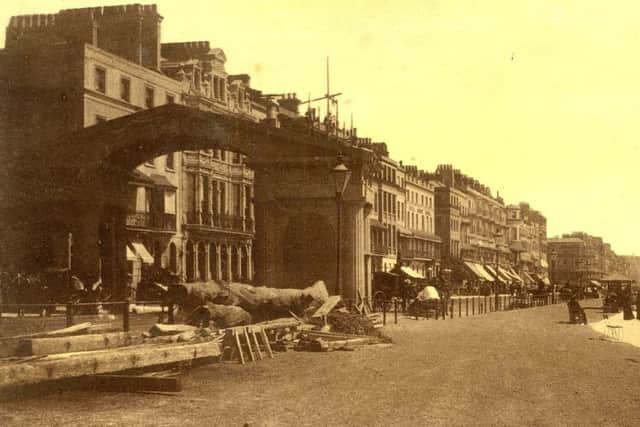

Archway and Boundary marker:
An albumen print dating from the mid 1870’s the seafront is now complete and notice the boundary marker, the post right on the edge of the parade. An uncluttered Hastings pier can be seen in the distance.
Archway and Pier:
Probably late 1880’s. Timber for wooden groynes can be seen stacked on the left, it was quite common for whole oak trees to be used the brace the groyne against the action of the sea. Hastings pier can be seen in the distance behind the lady in her bath chair.
Archway close-up:
Advertisement
Hide AdAdvertisement
Hide AdLooking Eastwards to Hastings and the bottom of London Road.
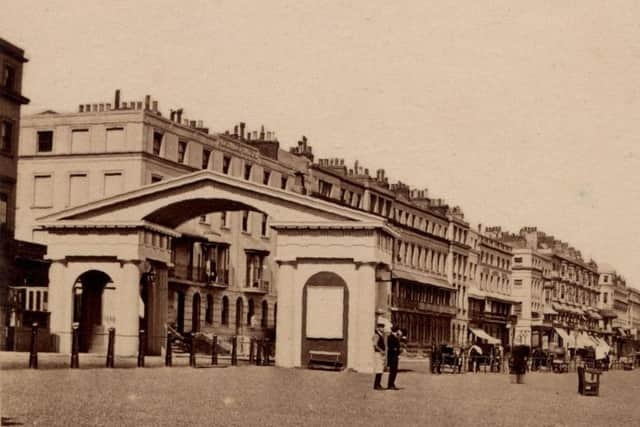

Archway from the Beach:
The seafront is instantly recognisable today but the rocks are now covered with shingle. The slipway opposite the bottom of London Road can be seen; coal boats would land here and the pulling-off anchors used to refloat them can still be seen at very low tides.
Archway looking west:
The buildings on the right were casualties to the Luftwaffe but the bow-fronted house once occupied by the Dowager Queen Adelaide, consort to William IV has survived.
Parsons 1891:
F.J.Parsons, one time proprietors of the Hastings Observer published the “New Illustrated Guide to Hastings & St.Leonards” which contained this image and comment. Other Parsons publications were equally uncomplimentary about the Archway.
St Leonards on sea, (East Boundary):
Advertisement
Hide AdAdvertisement
Hide AdPublished by Kershaw in the early 1860’s it show the colonnade on the left and the Conqueror Hotel that was removed in the 1930’s to make way for Marine Court.
East Lodge St Leonards, Hastings in the distance:
An early 1830’s lithograph drawn by Rowe and published by Wooll in High Street. Note the lack of any development and the road going over White Rock.
Don’t miss out on all the latest breaking news where you live.
Here are four ways you can be sure you’ll be amongst the first to know what’s going on.
Advertisement
Hide AdAdvertisement
Hide Ad1 Make our website your homepage at www.hastingsobserver.co.uk
2 Like our Facebook page at www.facebook.com/hastingsobserver
3 Follow us on Twitter @HastingsObs
4 Register with us by clicking on ‘sign in’ (top right corner). You can then receive our daily newsletter AND add your point of view to stories that you read here.
And do share with your family and friends - so they don’t miss out!
The Hastings Observer - always the first with your local news.
Be part of it.